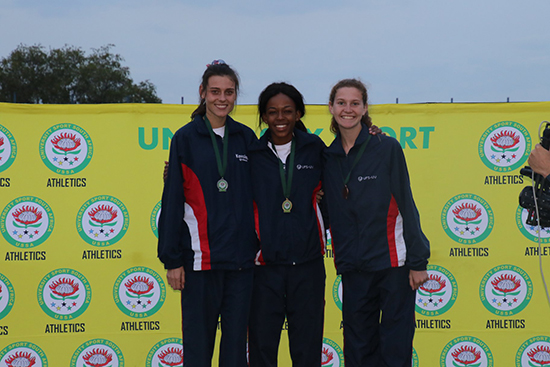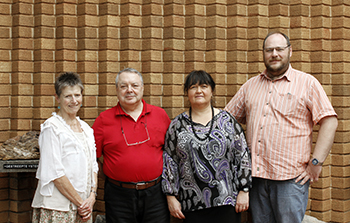Latest News Archive
Please select Category, Year, and then Month to display items
04 May 2018
Photo Facebook
 From left: Marné Mentz (second), Ts’epang Sello (first) and Tyler Beling (third) were in a class of their own, taking the first three spots in the 1 500m at the University Sport South Africa national championship in Sasolburg.
From left: Marné Mentz (second), Ts’epang Sello (first) and Tyler Beling (third) were in a class of their own, taking the first three spots in the 1 500m at the University Sport South Africa national championship in Sasolburg.
As expected, the Kovsie athletics team made the University Sport South Africa (USSA) national championship, held over the weekend in Sasolburg, one to remember.
Eight athletes earned gold medals, which is twice as many as last year. The total of 24 medals (including seven silver and nine bronze) is also double the number won in 2017.
They ended third, just one gold medal below the University of Johannesburg. The female athletes won the women’s competition and contributed to seven of the eight gold medals. The Kovsies dominated the 1 500m and 5 000m events in which they both claimed the first, second and third spots. They even grabbed the fourth and sixth position in the 5 000m in which Kesa Molotsane triumphed, with Tyler Beling second, and Marné Mentz third. Mentz and Beling swapped places in the 1 500m behind Ts’epang Sello.
Molotsane also won the 10 000m in a record time of 34:49.16 which is a massive three minutes and five seconds quicker than the previous record.
The 800m title also now belongs to Sello. She and Beling won a third medal (bronze) as members of the 4 x 400m relay women’s team.
The other gold medalist was Lara Orrock (3 000m steeplechase), Lynique Beneke (long jump), Esli Lamley (pole vault) and Rynardt van Rensburg (800m).
All five Kovsies who competed at the CAA Southern Region Youth & Junior Championships that took place over the weekend in Boksburg, won medals. They were Pakiso Mthembu (gold, 5 000m), Michaéla Wright (gold, long jump), Tyler (gold, 1 500m), Tsebo Matsoso (silver, 200m) and Orrock (silver, 3 000m steeplechase).
Famous mineralogists visit UFS Geology
2017-04-25

From the left: Prof Marian Tredoux, Associate
Professor at the UFS Department of Geology;
Prof Giorgio Garuti; from the University of Leoben,
Dr Federica Zaccarini, also from the
University of Leoben and Dr Freddie Roelofse,
Head of the Department of Geology at the UFS.
Photo: Rulanzen Martin
Years of academic friendship and collaboration is what makes Prof Giorgio Garuti and Dr Federica Zaccarini return to the University of the Free State (UFS) every so often.
The world-renowned academic duo from the University of Leoben in Austria were guest lecturers at the UFS Department of Geology. “We are here because we have known Professor Marian Tredoux and the Geology Department, for a long time. We are really happy to be here, and to be given the opportunity to present talks,” said Dr Zaccarini. The two are experts in platinum-group element mineralogy and each has given their surname to minerals namely, the Garutiite and Zaccariniite minerals.
Visit great advantage for research
They are acclaimed experts on very small minerals (smaller than a hundredth of a millimetre) with emphasis on platinum group elements in chrome-rich rocks. “Their visit is a great advantage for us. We also conduct research on these minerals and can learn from them,” said Prof Marian Tredoux, affiliated researcher at the Department of Geology.
Dr Zaccarini gave a lecture on Chromitites, and associated platinum-group elements, in ophiolites on Wednesday 5 April 2017 and Dr Garuti presented a lecture on Uralian-Alaskan complexes: a puzzling source of platinum, on Thursday 6 April 2017. During the talks they examined the association of the platinum-group minerals with chromite, rather than sulphide, and how this association can lead to the formation of unusual platinum-group element ores.
Collaboration on various academic papers
They and Prof Tredoux have collaborated on various research articles over the past four years, which have been published in various important international scientific journals. “These journals play an important role in calculating the H-scale which measures how important a researcher’s work is on an international scale,” said Prof Tredoux.